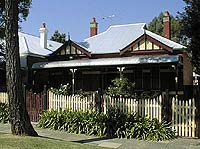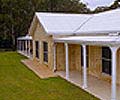Tools & Resources
Modern Steel Roofing for Heritage Buildings
Australia has thousands of buildings that showcase architectural styles prominent in the early days of settlement.
Many are buildings of significance, not only due to their age and appearance, but also because of the part they play in Australia's history.
Thankfully, many are still standing and in use, and many have been granted heritage classification to ensure they remain that way for future generations to enjoy.
They are all in various states of repair, some painstakingly restored to their original condition, some in need of great amounts of tender loving care. Whatever their condition, owners and restorers of these buildings have the opportunity to ensure these buildings remain true to the original intended architecture, while at the same time utilising products that will outlast and provide greater protection for the structure than those used originally.
Today, during Heritage Building restoration projects, the roof is an area that receives great attention, due to the battering from the harsh Australian environment over many years. Many of these roofs are made from a product that was known as 'corrugated iron'. If these roofs need replacing, the question that many restorers ask is "what should I use to replace the 'corrugated iron'?".
To assist in answering that important question, a quick explanation of the history of steel roofing material in Australia will paint a clear picture of what was available then and what is available now.
|
'Corrugated' is the common reference used to describe the shape (or profile) of material used in roofing and walling applications. 'Corrugated iron' as it was known, was produced in England in the late 1800's and exported to Australia under the "CUSTOM ORB®" brand name.
They were 'hot dipped' galvanised - a process which gave the sheeting an heavy, uneven zinc coating. These were in the form of standard length sheets approximately 2.4 metres long that had to be lapped from the ridge line of a home down to eaves level. Many such roofs were painted by the owner or builder after installation. This continued until World War I when corrugated iron became very scarce.
Consequently, John Lysaght decided to start operations in Australia in 1921. The sheets produced were then available in a number of lengths that reduced the need to lap sheets in many cases.
In 1976, ZINCALUME® steel zinc/aluminium coated steel commenced manufacture and rapidly gained market acceptance as a durable roofing material. Long term testing has shown that, in most environments, ZINCALUME® steel lasts at least twice as long as an equivalent galvanised coating while in some commonly occurring cases, it will last up to four times as long.
The next major advancement was the introduction of COLORBOND® steel prepainted steel. It is the result of years of technical development to produce the most durable and versatile roofing material available to Australian builders and home owners. Despite the improvement in technology over the years, its aesthetic appeal remains the same. COLORBOND® steel is protected by a total of eight layers of corrosion resistant alloys and oven-baked paints to easily weather anything the harsh Australian environment can deliver.
The following answers the question posed earlier. In the case of a Heritage building that was originally clad with short sheet, end-lapped galvanised steel (painted or unpainted) sheets, roofing made from ZINCALUME® steel or COLORBOND® steel would be a suitable replacement for the following reasons:
- The general shape (profile) of corrugated sheeting has not changed over the years, so the restorer can rest assured that the aesthetic appeal of the building will not be compromised by the use of a modern, extremely durable material.
- They are available in any length to suit the particular building. The result is that end lapping of sheets is not required, reducing the chance of leaks that are capable of severely damaging the important structure beneath. After all, as mentioned earlier, protecting the structure for future generations is a key objective of restoration projects.
- A roof with no end-laps also eliminates the possibility of water being forced to sit between the sheets due to capillary action. Water trapped between end laps will reduce the life of the alloy coating, bringing forward the onset of corrosion and reducing the life of the roof. Modern corrugated roofing is rollformed with anti-capillary side laps which reduce the chance of water being trapped between sheets at side laps.
- Installation of short sheet end-lapped roofing requires specialist knowledge to ensure that the correct installation and sealing techniques are used to reduce end lap capillary action. This specialist knowledge in the roof fixing industry is not in great supply since full length sheeting has been used for so many years.



